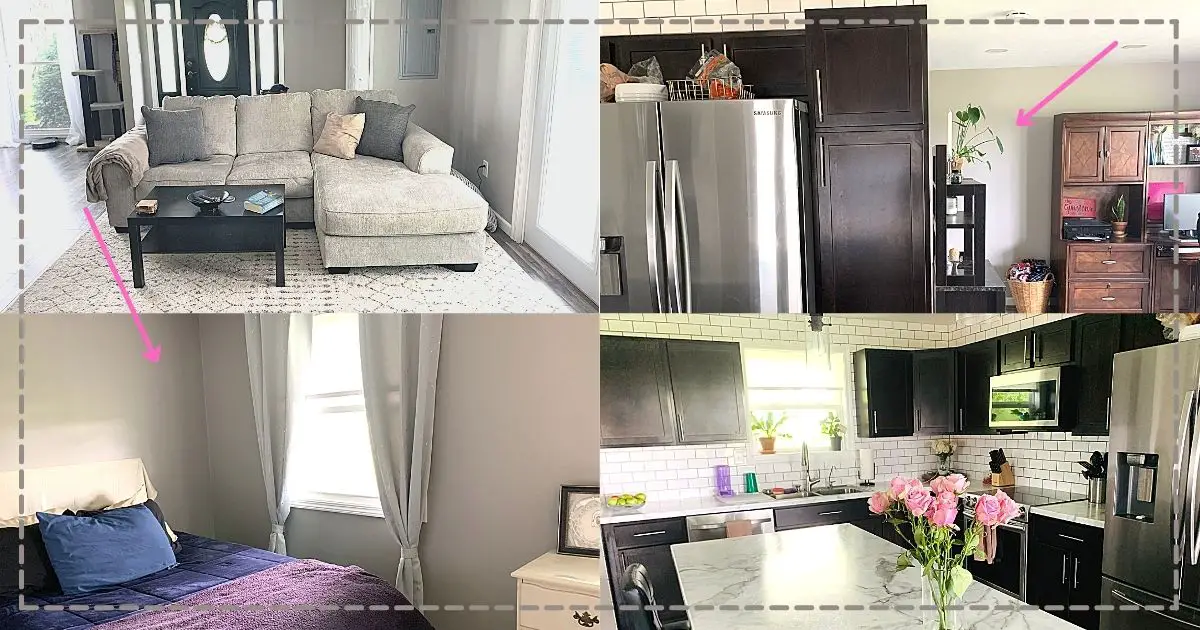*My posts may contain affiliate links, which means I may receive a small commission, at no cost to you, if you make a purchase through a link! Thank you for supporting my website!*
Last updated on February 28th, 2024 at 11:12 am
Wondering if all of the rooms in your house should match or not? Well, look no further because I have your answer!
All of the rooms in a house should have a common color scheme of 3 to 5 colors and 1 to 2 design styles to make the house feel cohesive and intentional without feeling too matching. Too many colors and styles make the house feel overwhelming, disjointed, and chaotic.
Now that we’ve got the basics out of the way, let’s break into the details a little further so you can decorate to make your home feel more cohesive.
Let’s dive in!
Quick Navigation: General Rules For Making All Of The Rooms In A House Feel Cohesive Without Matching
- Keep The Walls The Same Color Throughout The House
- Keep The Hardware The Same Color Throughout The House
- Mix & Match The Furniture Colors
- Mix & Match The Decorations
- Don’t Do It All At Once
- Other FAQs About Decorating Your House Cohesively
- Final Thoughts
One: Keep The Walls The Same Color Throughout The House
The first step to helping the house feel cohesive but not overly matching is to keep the wall paint the same color throughout the entire house.
There are several benefits to using the same paint color throughout the entire house.
(You can see all of the pros and cons of painting the whole house one color in my article here. I explain it in a little more detail to help you make your decision. But I’ll highlight some of the key points here.)
The same paint color helps you feel like you’re in the same house as you walk from room to room.
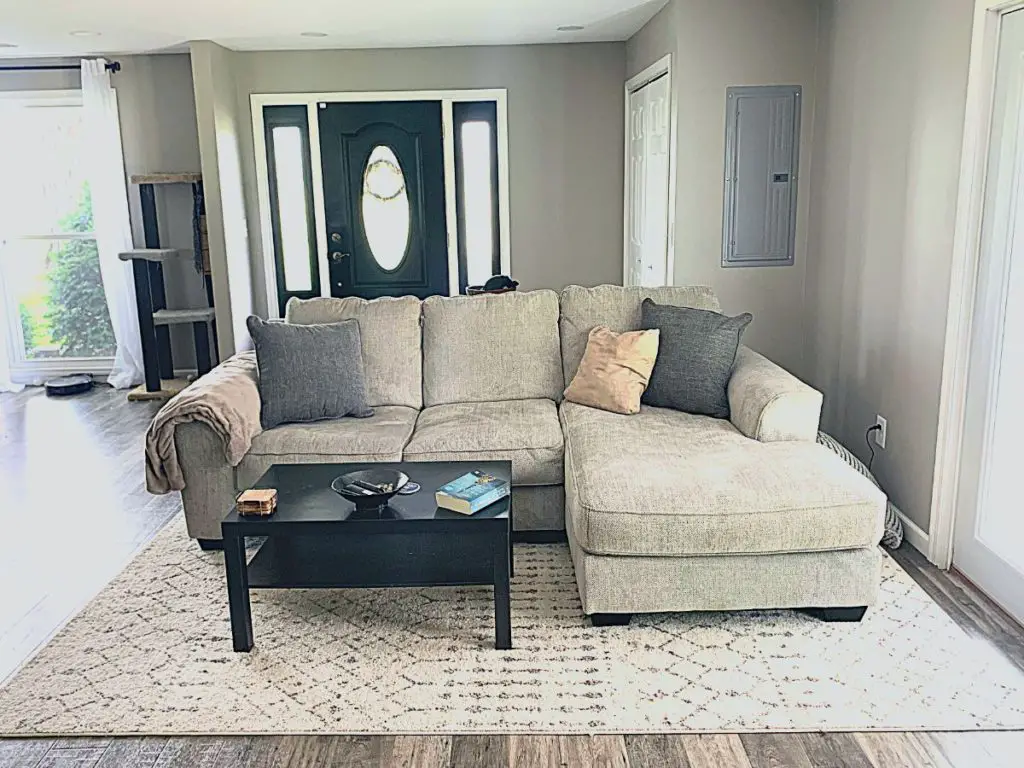
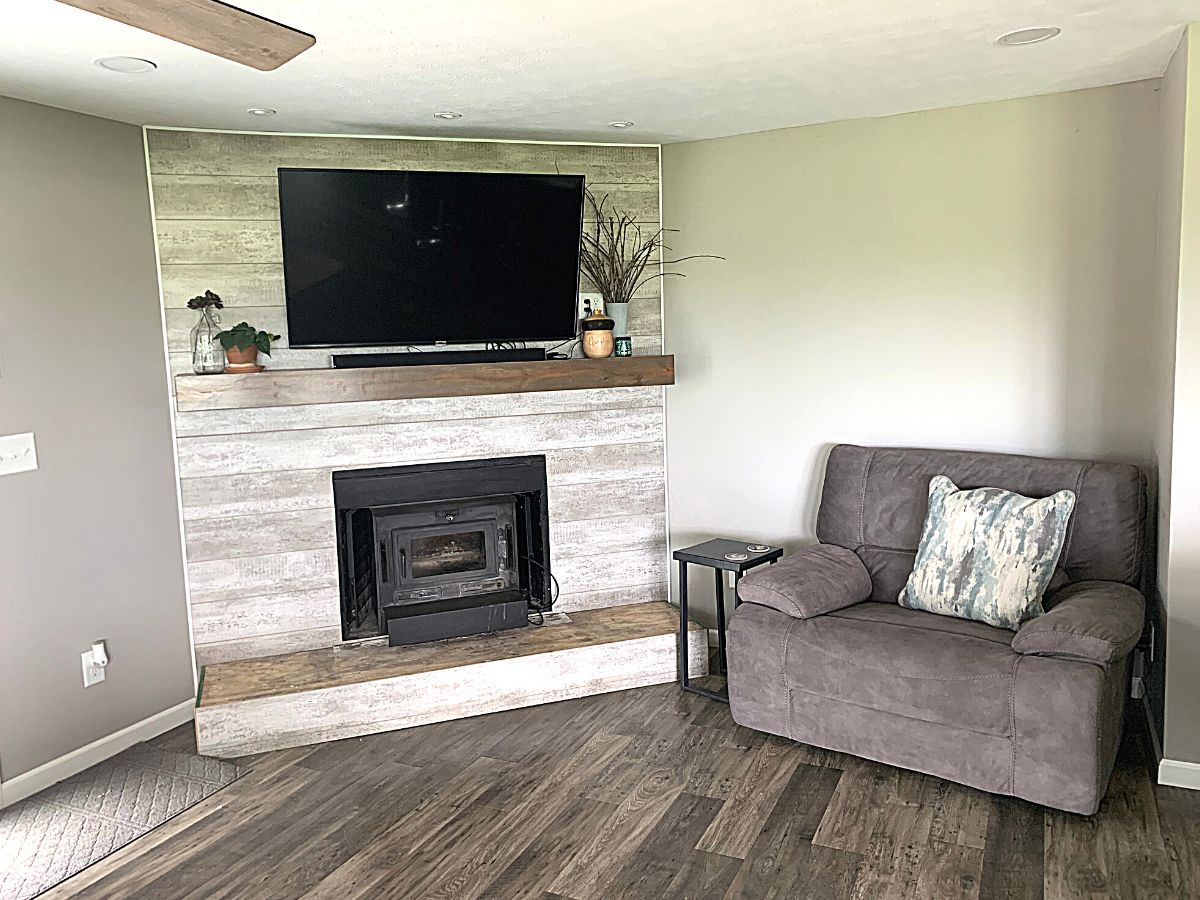

Your brain wants each room to make sense together. If one room is navy blue then the next room is seafoam green and the fourth room is a stark gray then your brain will feel overwhelmed and the entire house will feel disjointed and chaotic.
Instead, if all of the rooms are a light neutral color (white, gray, beige, greige, etc.) and the decorations are the pops of color, then the rooms flow better and they do not feel overly matching.
In addition, furniture can easily be moved from room to room because the color scheme is the same throughout the house. This saves a ton of time and money.
Sometimes furniture doesn’t work out in one room but is perfect for another room. If the rooms have the same color walls, then the furniture can easily be moved around to create an entirely new look and feel without you having to spend another dime!
In general, you want to choose a light neutral paint color (especially if you love bright and bold colors). I explain why this is the best paint color option to make your whole house feel cohesive in this article.
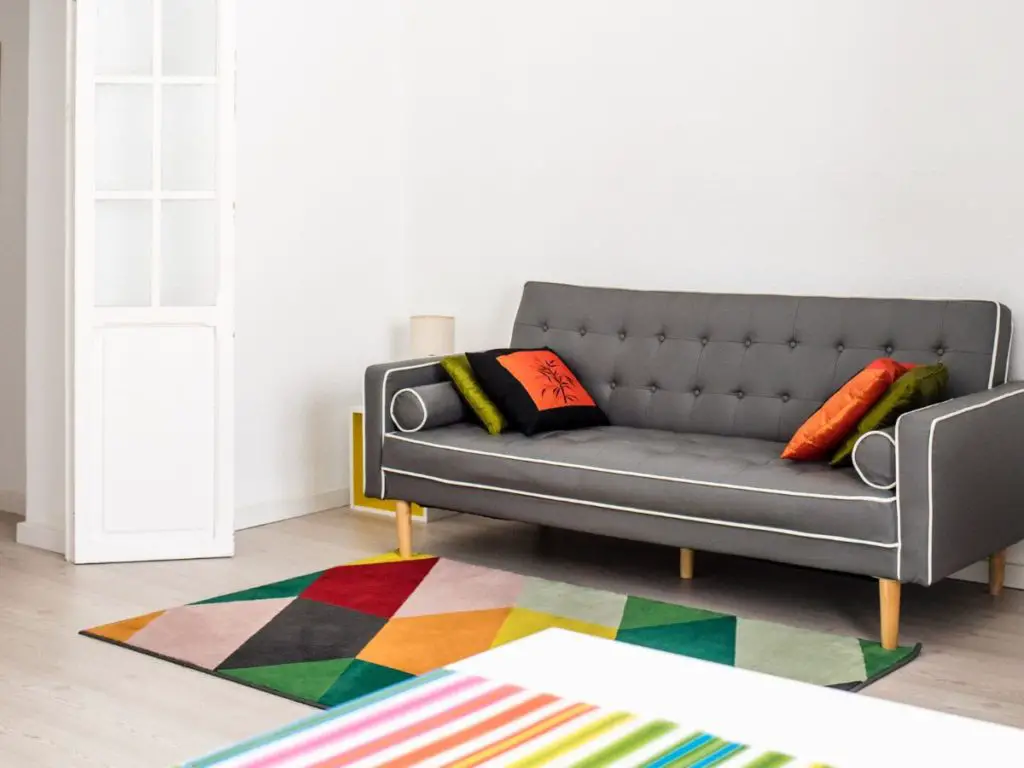
Can You Add A Painted Focal Wall To A Room & Still Have The House Feel Cohesive?
Some rooms do benefit from a painted focal wall (such as a fireplace in a living room or the wall behind the headboard in a master bedroom).
But not ALL rooms need a painted focal wall.
You can add a focal point with the decorations or a shelving unit that can be changed up more easily rather than having to repaint a focal wall every few months when you get tired of the latest paint color of the year.
But of course, this is a personal preference and each house is unique, so use your best judgment on which rooms need a painted focal wall and which rooms do not!
As long as the painted focal wall fits into the 3-5 colors and 1-2 design styles you picked for your whole house color and design scheme, then the room will still feel cohesive with the rest of the house.

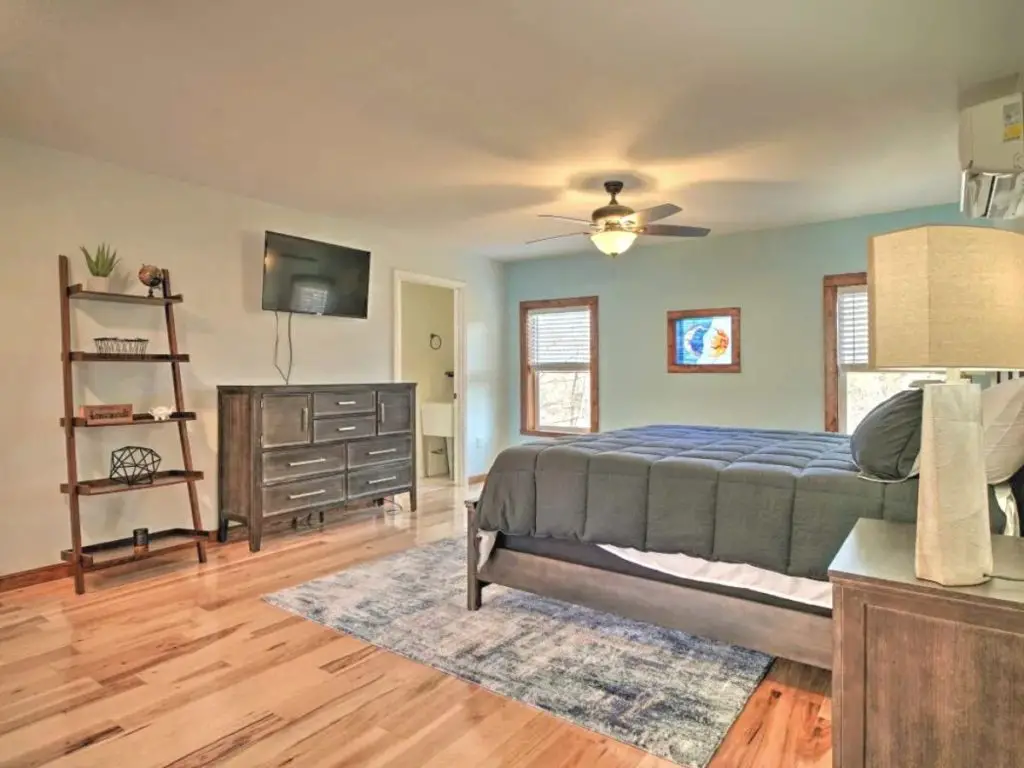
Two: Keep The Hardware The Same Color Throughout The House
The next step to helping the house feel cohesive but not overly matching is to keep the hardware the same color throughout the house.
Door knobs, door hinges, cabinet handles and pulls, sink faucets, and shower heads should all be the same color throughout the house.
Just like the wall color, these items are going to help the rooms flow together and feel cohesive.
If these metals are overly mixed and matched, then you’ll have a hard time keeping to the 3-5 colors throughout the house. Plus, your house will look pieced together instead of intentional and thought out.
Any of the metal colors (silver, gold, bronze, or black) can be a great base color and will be cohesive with any color of furniture and decor.
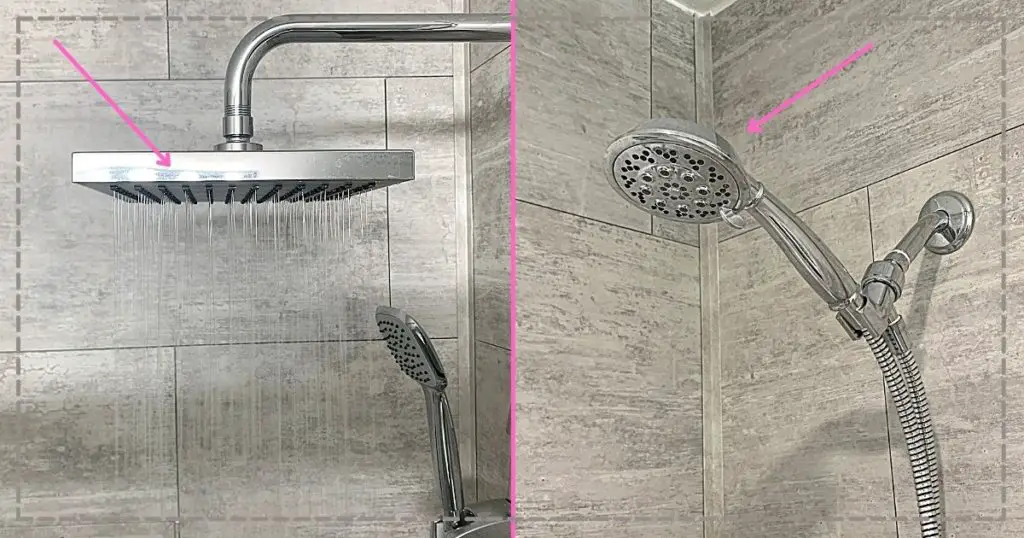
If your house has several different colors of hardware, don’t switch them all at once. Take your time and every month switch out one thing with the new color you are using moving forward.
This will help you get the look you want without having to drop a ton of money all at once.
Or better yet, some of this hardware can be spray painted!
Cabinet handles and pulls and door hinges are easy items to spray paint and put back in. You’ll immediately update the look of your home with this simple DIY project.
I like using Rustoleum’s spray paint found at Amazon. You can spray paint the color you want (yes, even silver and gold), then spray a clear coat overtop which I’ve found makes the paint job last longer.
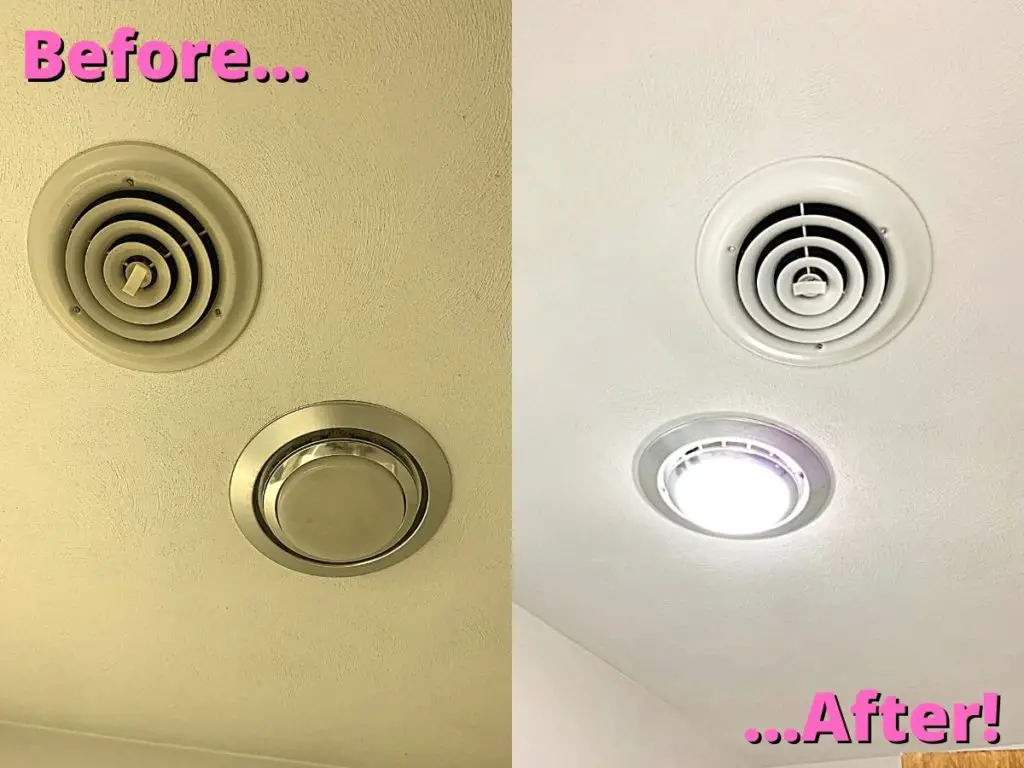
Three: Mix & Match The Furniture Colors
The next step to helping the house feel cohesive but not overly matching is to mix and match the furniture colors.
So far, we’ve talked about the items that should match throughout the house to make all the rooms feel cohesive. Now let’s talk about the things that should not “match” from room to room.
Furniture is the first area where you want to start mixing up things (not keeping everything exactly the same throughout the house).
Since furniture is still an expensive area to change regularly, we want to keep these as neutral colors as well so they can work with all other colors we choose to use throughout the house.
As we talked about with the paint color, sometimes we buy a furniture piece for one room and realize later it works better in another room.
If the rooms have a similar color scheme then the furniture can easily be moved around which will save you a TON of money AND make the furniture/room feel like new.
So, how do we buy neutral-colored furniture that doesn’t feel too “matchy-matchy”?
How To Choose Furniture Colors That Make The Entire House Feel Cohesive
The best-decorated houses have this “collected” feel which is brought in by having different colored and shaped furniture pieces.
To accomplish this, you should stick to 2-3 different neutral color pieces for your furniture throughout your entire house and try to mix up the color of the furniture pieces right next to each other.
Here are some examples:
- Light brown wood bed frame & headboard paired with black nightstands
- Gray/beige chenille couch with black side tables and medium/dark brown wood coffee table
- Black barstools with white kitchen island cabinets
- Cream linen upholstered dining chairs with light brown wood dining table

By mixing up the colors and materials of the furniture right next to each other, you are creating contrast in the room.
And since all of the rooms have a similar color scheme and design, each room can be wildly different, but still, make the whole house feel like it flows together.
Four: Mix & Match The Decorations
The next step to helping the house feel cohesive but not overly matching is to mix and match the decorations.
The easiest and cheapest items to change when either you get bored, the seasons change, or the trends change are the decorations.
Throw blankets, throw pillows, lamps, books, knick-knacks, bowls, light fixtures, vases, rugs, shower curtains, towels, etc are all relatively inexpensive items that can be swapped out much easier than the furniture, hardware, and wall color of your home.
In general, you want to use a variety of styles, shapes, colors, and textures to make your house not feel matchy-matchy but still cohesive.
Each room will have its own decorative focal point that will be completely different (yet similar in colors) from the next room so you still feel like you’re in the same house, but you’re still able to create contrast from room to room.
If you do this part right, then you can easily move your decor from room to room whenever you need a refresh and you can get a completely new look in a room without needing to spend a single penny (my fave!).
Now, how do we accomplish this?
How To Choose Decorations That Make The Entire House Feel Cohesive
There are a few things you want to remember while choosing decorations:
- Stick to the 3-5 colors and the 1-2 design styles you chose for your whole house
- Size matters (bigger is usually better)
- Mix and match textures and colors that are directly next to each other
- Decorate in groups of 3-5
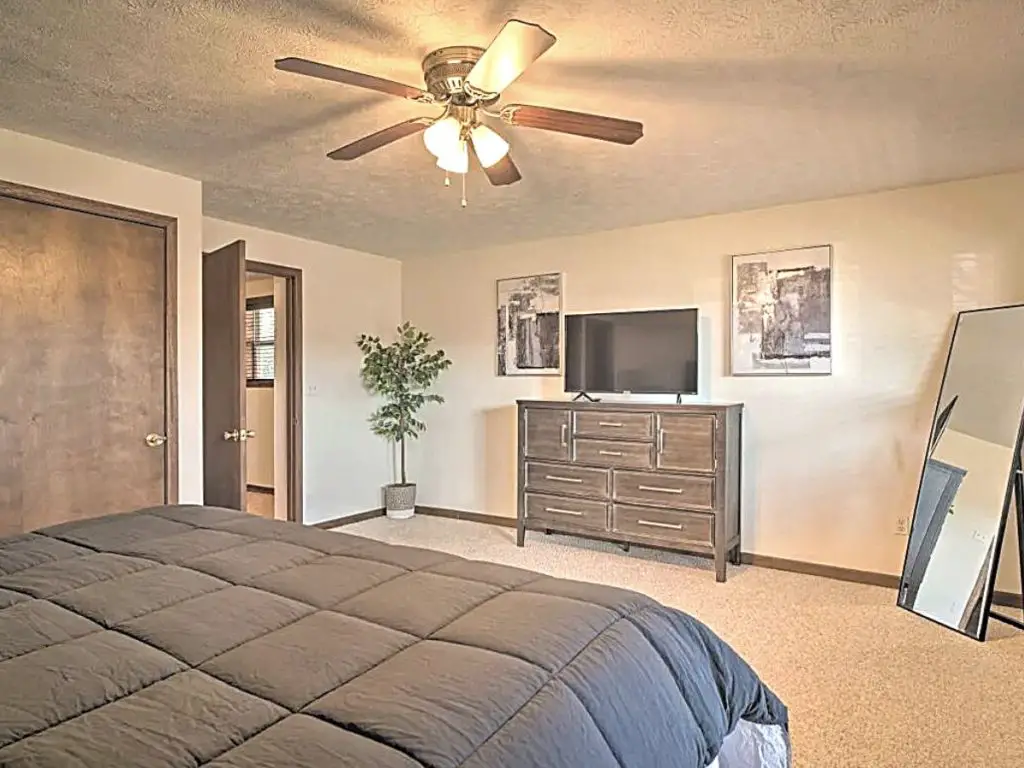
Choose A Whole House Color Scheme
The color scheme is probably the easiest part of choosing decorations.
If your walls and furniture are a neutral color, then you can choose whatever color you are loving at the moment to pack a major punch of drama into your room.
For my color schemes, I like to stick to super neutral, minimal colors. I like to use white, black, gray/silver, green (from plants), and a brown undertoned wood color such as walnut.
For someone who loves the color blue, I would use blue, white, gray/silver, green (from plants), and an orange or red undertoned wood color.
Or for someone who loves lots of bright colors, I would use various shades of two bright colors along with white, green (from plants), and a complementing undertoned wood color to the two bright colors.
Are you catching where I’m going with this?
Plants, wood, and white go with any color scheme so use those three colors as your base and build from there.
You can stick to those three colors or add two more colors of your choice to create the perfect whole house color scheme.
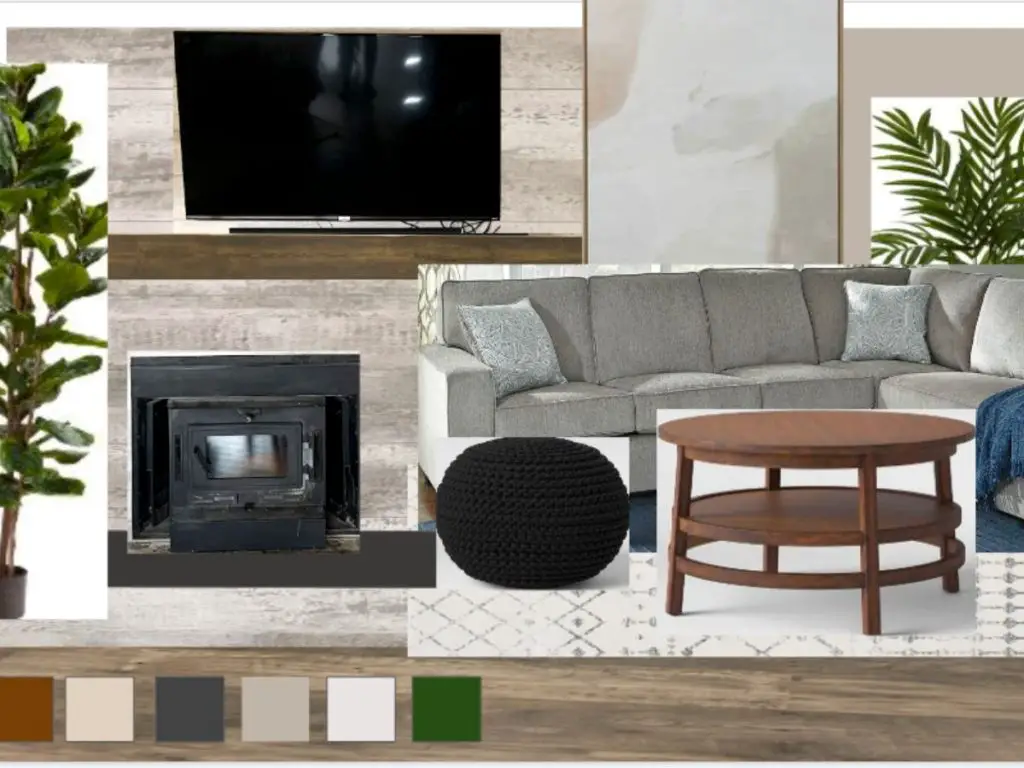
Choose The Correct Size For Decorations
After you’ve chosen the color scheme, the second most important element of choosing decorations is their size.
The size is going to either make your room feel large, clean, and well balanced, OR it is going to make it feel tiny, cluttery, and off-kilter.
It is better to choose fewer, but larger decorations than to have several small decorations.
Here are several examples:
- Choose 1-2 large wall art pieces over 4+ small pieces of wall art creating a photo gallery
- Choose 1 large 8 x 10 or 9 x 12 area rug over several smaller 5 x 7 (or smaller) rugs in a room
- Choose 2-3 large pillows over 4+ small pillows

I know these larger pieces of decor are more expensive than the smaller ones, which is exactly why we try to get away with the smaller pieces.
But think about this.
You are probably spending the same amount of money to get several small decorations that just make your room feel cluttery as if you just bought the one or two larger pieces from the beginning that truly balance out and complement the room.
So you might as well get the larger pieces that make a statement and help your room look cleaner and larger than piecemealing the whole thing together.
As soon as I understood that concept, my thoughts on choosing decorations changed forever.
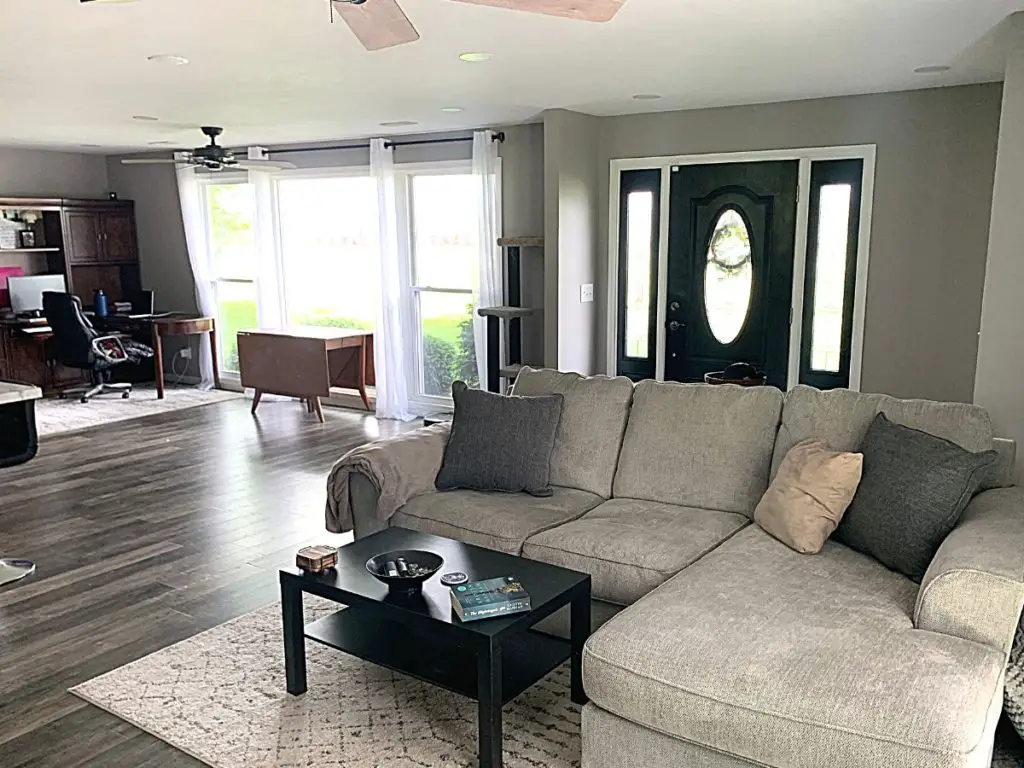
Decorate Knickknacks/Smaller Decorations In Groups Of 3-5 (Mix & Match Colors & Textures Next To Each Other
The final area to consider when choosing decorations is how they will be styled next to each other.
A good rule of thumb is to decorate smaller items in groups of 3-5 with one item being vertical, one item being horizontal, and one item having an organic shape.
Here is a list of items to consider when mixing and matching decorations. Try to get one item from each category in your group of 3-5.
| Vertical Decorations | Horizontal Decorations | Organic Shaped Decorations |
|---|---|---|
| Picture frames | Books | Figurines |
| Tall artwork | Bowls | Plants |
| Vases | Trays | Sculptures |
| Tall plants | Wide/stout plants | Uniquely shaped vases |
| Tall mirrors | Wide mirrors | Wood beads |
| Other items that are taller than they are wide | Wide artwork | Other items that aren’t uniform in shape |
| Other items that are wider than they are tall |
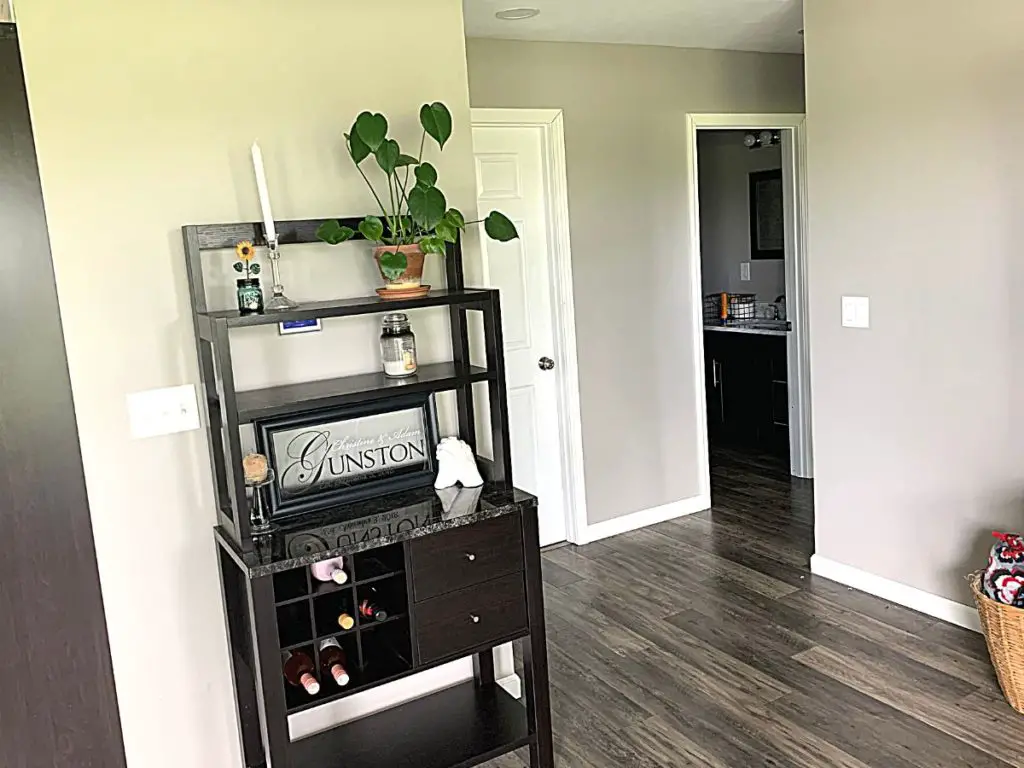
In addition to grouping one item from each of these categories together, make sure the color and texture of each item are different from the one directly next to it.
For example, if you have a side table to decorate, you can use a:
- Large ceramic lamp (vertical, ceramic, cream/gray)
- Stacked books with a wide picture frame on top (horizontal, paper, black or navy blue, glass)
- Wide plant in a small ceramic vase (horizontal and organic, ceramic, white, green plant)
Five: Don’t Do It All At Once
The final step to helping the house feel cohesive but not overly matching is to NOT do it all at once!
Believe me, I get the strong pull you’re probably having right now to dive in and do it all at once to get it over with.
I have a constant battle in my own head between wanting it all done right this second and wanting to take it slow to make sure I only incorporate pieces I love into my home.
But the best-decorated homes are collected over time and each piece is thought out before being chosen.
Collecting the right pieces of furniture and decorations and filling out your home takes time.
The best way to collect items for your home is to get one item at a time and live with it for a few weeks before you get the next item.
Tackling the decorating phase of your home this way will help you save time and money over the long run because you can be very picky about what you bring into your home.
It does not all have to be done today.
And if you do all of the things mentioned in this post, over time, your house will feel cohesive, clean, modern, well-thought-out, and balanced.
Nothing will feel “matchy-matchy” or cluttery, and you will love your home that much more because you will have added each piece with thought and love.
As a final thought, I also recommend pulling your color scheme and style choice to the exterior of your house. It will make the entire house feel like a cohesive and complete package!

Other FAQs About Decorating Your House Cohesively
Here are some other frequently asked questions about decorating to help you design your house cohesively.
Should All Rooms In A House Have The Same Style?
All rooms in a house should have the same style(s) so that each room feels cohesive and flows easily into the next. Using the same colors and styles in all rooms helps a house feel well-thought-out and balanced as opposed to cluttery and pieced-together.
Does The Kitchen & Living Room Need To Match?
The kitchen and living room should match if the room is an open concept. Since one room flows directly into the next, they should be the same color scheme and style. If the kitchen and living room are separate, they will still benefit from the same color scheme and style.
How Many Colors Should Be In A House?
A house should have 3 to 5 different colors to create a beautiful and cohesive color scheme. The best mixture of colors in a house is 1-2 bold colors, 1 neutral color (such as white or light gray), 1 wood tone color, and 1 green plant color.
Final Thoughts On Decorating Your House Cohesively
There you have it!
These are the design principles that I am using to slowly decorate my house and make it feel more cohesive.
Hopefully, some of these design tips will help you decorate your house with much greater ease as well!
Catch you in my next post!
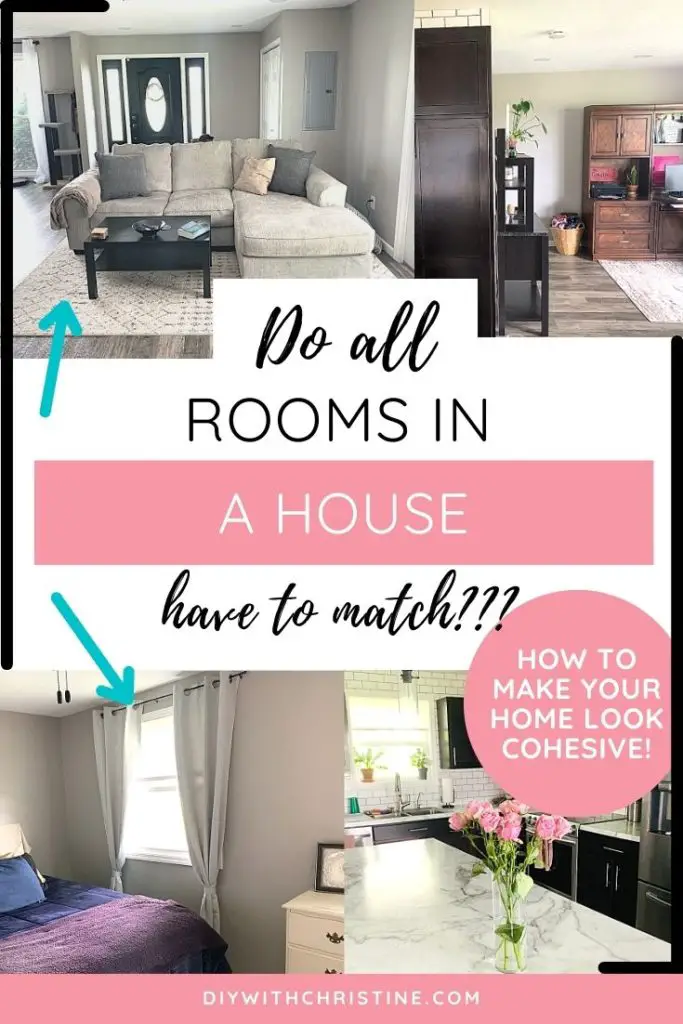

By Christine
Christine is a blogger and DIYer who tackles home renovation and decorating projects alongside her husband, Adam, for their personal residence and rental properties. Although she successfully tackles large renovation projects to avoid expensive contractor fees and bring her vision to life now, her path to success was not easy.
Go here to read her story, “From a Clueless First-Time Homebuyer To A Confident DIYer Creating Her Dream Home One Project At A Time“.
Popular Posts
DIY With Christine is a participant in the Amazon Services LLC Associates Program, an affiliate advertising program designed to provide a means for sites to earn advertising fees by advertising and linking to Amazon.com.

